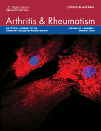Impact of the CTLA-4/CD28 axis on the processes of joint inflammation in rheumatoid arthritis
Abstract
Objective
The importance of the costimulatory molecules CD28 and CTLA-4 in the pathologic mechanism of rheumatoid arthritis (RA) has been demonstrated by genetic associations and the successful clinical application of CTLA-4Ig for the treatment of RA. This study was undertaken to investigate the role of the CTLA-4/CD28 axis in the local application of CTLA-4Ig in the synovial fluid (SF) of RA patients.
Methods
Quantitative polymerase chain reaction was used to analyze the expression of proinflammatory and antiinflammatory cytokines in ex vivo fluorescence-activated cell sorted CTLA-4+ and CTLA-4− T helper cells from the peripheral blood and SF of RA patients. T helper cells were also analyzed for cytokine expression in vitro after the blockade of CTLA-4 by anti–CTLA-4 Fab fragments or of B7 (CD80/CD86) molecules by CTLA-4Ig.
Results
CTLA-4+ T helper cells were unambiguously present in the SF of all RA patients examined, and they expressed increased amounts of interferon-γ (IFNγ), interleukin-17 (IL-17), and IL-10 as compared to CTLA-4− T helper cells. The selective blockade of CTLA-4 in T helper cells from the SF in vitro led to increased levels of IFNγ, IL-2, and IL-17. The concomitant blockade of CD28 and CTLA-4 in T helper cells from RA SF by CTLA-4Ig in vitro resulted in reduced levels of the proinflammatory cytokines IFNγ and IL-2 and increased levels of the antiinflammatory cytokines IL-10 and transforming growth factor β.
Conclusion
Our ex vivo and in vitro results demonstrate that the CTLA-4/CD28 axis constitutes a drug target for not only the systemic, but potentially also the local, application of the costimulation blocking agent CTLA-4Ig for the treatment of RA.




